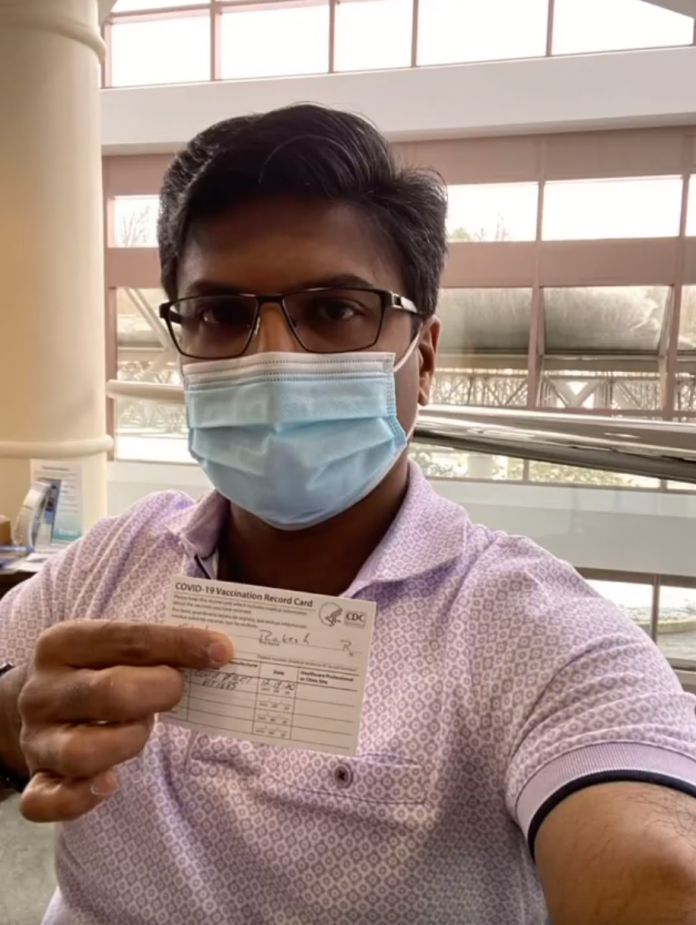Dr. Rakesh Shah had only one complaint about his experience receiving the COVID-19 vaccine – he couldn’t get a happy face BandAid. But after being injected with both doses of the Pfizer-BioNTech option and having zero side effects, a plain one is just fine with him.
The cardiologist and president of medical staff at Langhorne’s St. Mary Medical Center recently took to his food-related @thecookingcardiologist Instagram to chronicle the vaccination process and help alleviate public fears. Ever since the vaccine was released, Shah was inundated with questions. Is it safe? Isn’t it better to just get COVID, which has a high survival rate?
“I thought, maybe the best thing to do is document my experience, thought process, just to give people a level of comfort that a healthcare professional believes in the science,” Shah told The Times. “It was really a mission to educate and make sure that proper information was given out. There’s so many myths out there that people were concerned about, so I wanted to dispel them.”
A huge misconception, explained Shah, is that vaccine recipients are injected with the coronavirus. He stressed that this isn’t the case. Rather, the vaccine contains a small component of the virus’ genetic material, which allows the body to form a specific type of protein to then fight off the virus.
“We’re really injecting a very specialized piece of the virus. It’s not the virus itself,” said Shah. “So, if we do get exposed to the coronavirus, the likelihood of getting really sick from it is incredibly low.”
Shah added that the vaccine doesn’t necessarily prevent infection. Its purpose is to “fight the infection off rapidly and with minimal illness.”
On Instagram, Shah walked viewers through part one of his vaccination. First, vaccine recipients must fill out a form that asks if they have COVID-19 symptoms or were exposed to an infected individual. According to Shah, if a person is knowingly COVID-positive, they should wait until they’re negative to be vaccinated.
“What we don’t want is someone who’s actively sick to receive the vaccine because it may alter your immune response,” he said. “We’d rather you recover from what you have ongoing and then take the vaccine.”
Next, Shah was given his vaccination card, which includes his name, demographics, type of vaccine (Pfizer or Moderna), date of administration and the date he was set to return for his second dose. He recommended that people take a picture of the card in case they lose the original. Finally, he was vaccinated, boasting a calm, laid-back demeanor the entire time.
“No one’s arm has fallen off so far,” he said with a laugh as the vaccine administrator broke the sad news that only plain BandAids were on hand.
After sitting in a designated observation area for 15 minutes and having no bad reaction, Shah was free to go. Some may experience low-grade fever and chills, but this typically goes away within a day or two. Shah was given the second dose of the Pfizer vaccine about three weeks later and had no negative side effects.
For those with an innate fear of needles, Shah shared some advice.
“It’s such a small needle and you can barely feel it going in,” he said. “The best advice is to think about, would you rather have COVID and the potential effects that you can have from COVID and possibly post-COVID syndrome? Or a relatively quite well-tolerated vaccine given through a very small needle? Think about why you’re taking the vaccine.”
As for those who are fearful of the vaccine because of its record-breaking turnaround time (most vaccines are tested for at least two years), Shah encouraged them to look at the bigger picture.
“We don’t have that kind of time with this pandemic. Too many people are affected,” he said. “If I get the virus, there’s a pretty significant chance that I could potentially get sick. However, given the vaccine, we know from the large trials that the likelihood of getting a severe illness is next to nothing.”
Once an individual is fully vaccinated, Shah stressed the importance of continuing COVID-19 mitigation efforts, especially mask-wearing and social distancing.
“We still need to behave responsibly. We still need to mask until the authorities say that it’s OK to take our masks off in public,” Shah said. “The reason being is, we still need to curb this pandemic. We still need to make sure there are enough people that have been vaccinated so that we’re all immune. I pray for that day. We’re all praying for that day. More to come, but if we achieve enough immunity, I don’t see why we wouldn’t be able to.”
When asked whether the COVID vaccine must be received annually like the flu shot, Shah said it’s a “great unknown” as health professionals continue to learn about this novel virus.
Currently, Pennsylvania is in Phase 1A of vaccine distribution, which includes essential healthcare workers and long-term care residents and staff. Those in Phases 1B and 1C, slated to begin sometime in February, are able to pre-register. These groups include older adults and a broader selection of essential workers, such as school staff, grocery store workers and public transit employees. More information can be found at covid19-vaccine-bucksgis.hub.arcgis.com/.
Samantha Bambino can be reached at [email protected]


